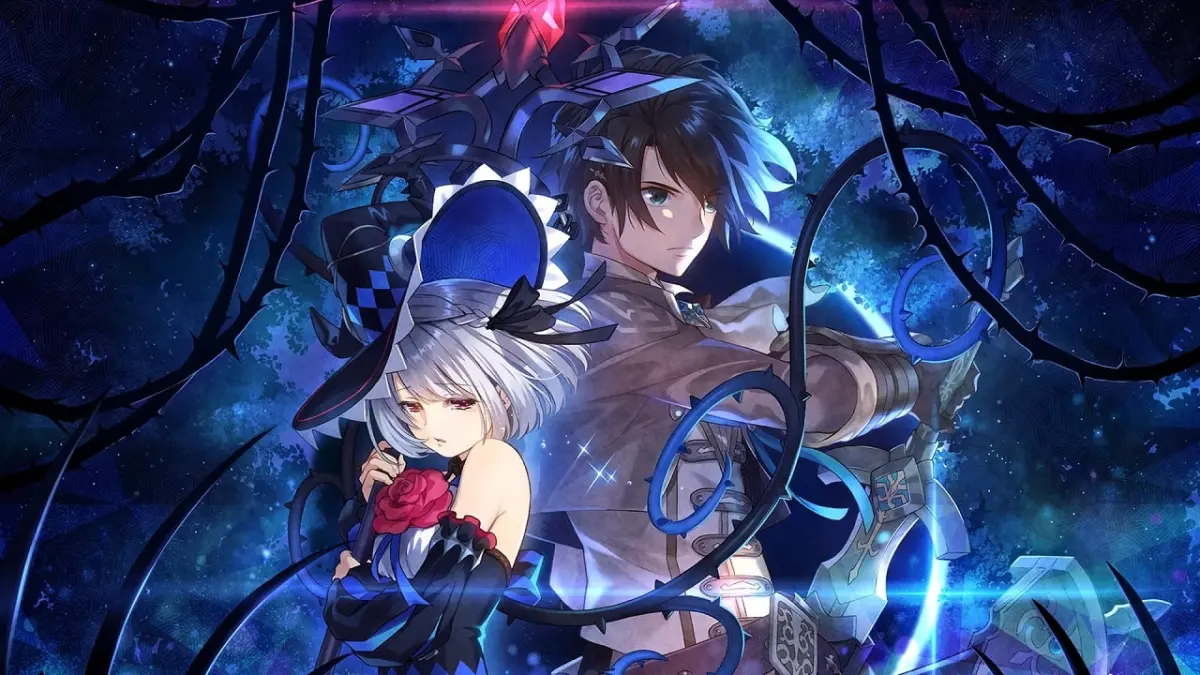As my party defeats yet another dragon, I can’t quite find cause to celebrate. In the past, I would happily look forward to loot, exp and money. I could go back to town and revel in triumph as I leisurely use my newfound spoils to strengthen my characters in preparation for future encounters.
Instead, I’m forced to keep my party out in the wilderness without any form of respite, moving ever closer to an unclear end. There is no light at the end of this tunnel — just the start of another. My journey, better characterized as a desperate mission, isn’t done for the sake of adventure or self-discovery, there’s just one goal: to deny fate.
This is Dragon Star Varnir, the latest JRPG under Compile Heart’s Galapagos RPG brand.
And after spending a few evenings with it, I can easily say that few games have ever filled me with so much dread. Being forced to confront the mortality of my characters in terms of both gameplay and narrative was a harrowing experience — something that Compile Heart has become increasingly proficient at portraying.

You see, the beings at the heart of Dragon Star Varnir, witches, lead a doomed existence.
Sure, everyone dies eventually, but witches have got it bad. Not only are they born with dragons inside their womb who rip their “mother’s” stomach upon reaching maturity, but since their progeny are destructive beings that attack humans on sight, the Empire formed a military group, the Knights of Requiem, whose sole goal is to kill any witch they come across without question.
Simply put, a witches life is one full of fear, and it typically ends in one way: a violent death.
And from the perspective of protagonist Zephy, who becomes a witch following an encounter with a dragon, we’re granted a first-hand look at his eventual comrades’ daily struggles and how he copes with the reality that not only is he now what he once hated, but also shares their fate.
Fortunately, a chance encounter with a mysterious witch named Charlotta gives both him and his fellow witches a glimmer of hope: a way to free themselves from the dragon within, and the chance to live ordinary lives.
And so sets the stage for Dragon Star Varnir, a tale about mortality, insanity and despair.

If you were to ask me of my main complaint of Galapagos RPG-branded titles, then it would be that they’re often deeply flawed in one or two areas, resulting in the devaluation of the overall product. Omega Quintet, for instance, was hurt by having vague and easy to miss conditions for the True Ending, as well as an unfair battle system, while Death end re;Quest might have had a fantastic narrative, but it often felt like that came at the expense of almost everything else.
Compared to such titles, Dragon Star Varnir feels like a more complete, cohesive game. Outside of the lazy affection system, which has Zephy give gifts to his teammates in order to witness extra scenes and character development, everything you’d want in a JRPG that was missing from previous titles in some capacity is here. Quests? Yes, and they require little guesswork. Crafting? Outside of accessories and consumables, you can make different types of anything you’d want. Bestiary? A strange flex, but it’s got that too.
Overall, it doesn’t shine as brightly in specific areas like other Galapagos RPG titles do, but its not lopsided like the others are either.
For instance, let’s take a look at what is one of the more notable aspects of any Galapagos RPG title: the battle system.
Battles take place in the air, and if you can get past the comical sight of reused enemies from past games now walking or swimming in the sky, then you’ll likely have a good time.
There are three levels, and each participating character has the option of either staying put to cast a spell, or moving between levels in order to physically attack a target on the same level or receive stat bonuses based on a formation you can select in the pause menu. It’s fairly standard at the start, but gets quite entertaining once you unlock attacks that can forcibly move enemies around the field and cause them to collide with one another.
And it’s at this point when I’d normally discuss how things suddenly go downhill around the midgame once sudden difficulty spikes and enemies with bloated health pools begin to crop up; but not only does the difficulty stay mostly consistent, but all enemies (save for bosses) become increasingly susceptible to a set of instant-kill techniques, called “Devour” skills, as their health decreases.
Speaking of which, Devour also plays an integral role in character progression.

Every dragon has a core that house a unique set of skills, abilities and stat boosts a character can acquire. The ones that automatically drop from bosses are shared amongst the party, but those from regular enemies only apply to the character who devoured the respective enemy.
By designing things in this manner, the player is free to develop their party any way they’d like.
Want to take advantage of Laponette’s unique weapon properties by making her a physical attacker? That’s a viable option. How about having Karikaro double down on her strengths as a mage? Go right ahead. In fact, anything is possible so long as the total allocation cost doesn’t exceed a certain limit.
The only criticism I have here is that nothing indicates whether a character has devoured a specific dragon before — a weakness that will make itself known depending on the circumstances.
Regardless, I can’t stress enough how much fun I had with this system. Finding new dragons, discovering new abilities, and tweaking character builds was no doubt the highlight of the game for me. It’s just a shame that it’s something you won’t have full freedom to tinker with for most of the game.
Why? Because Dragon Star Varnir has a soft time limit.

Remember how I mentioned earlier that every witch has a dragon in their womb? Well, your objective is to clear most of the game (ch.4 ~ 10) before they’re born. It’s not your party you have to worry about though — it’s the well-being of three adorable little girls, dubbed the Little Sisters, back at the Witches’ Den that’s your concern.
Honestly, I’m still conflicted on how I feel about this.
On one hand, the very premise is low-hanging fruit. Though I eventually gained an attachment to the Little Sisters (and the other characters) once the story began to actually pick up, I knew nothing about them when the mechanic was first introduced. As such, aside from being necessary for the True Ending, my reasons for wanting to keep them alive were purely visceral: they were cute and I wanted to protect them.
But on the other hand, I’d be lying if I said this design didn’t do wonders for the overall atmosphere and tension. The Little Sisters creep ever closer to insanity as time progresses, so I’d often return to find them crying about their head feeling like it’s splitting apart if I took too long while out on a mission or sidequest. And though feeding them dragon blood and meat alleviates that pain, doing so too many times causes them to give birth anyway. It’s a no-win situation, and it meant I always felt pressured to play efficiently since I didn’t know when I’d have another chance to return home and feed them.
Let me be clear though: the time limit isn’t too strict. I got the True Ending on my first attempt despite making some careless mistakes early on. So long as you buy dragon meat and don’t spend too much time in any given area for any reason, you’ll be fine.
If anything, my issue with the time limit is how it interferes with everything else.

To be blunt: I found it ironic that after finally getting so many individual facets right, the developers opted to go with a design that restricts access to them.
For instance, remember how I said there are no real difficulty spikes? I lied. Sort of.
Since you can’t spend the time to fight every dragon in any given area, there will inevitably be times when some characters start to lag behind in skills and abilities. And in the off chance you do decide to go out of your way to hunt down specific dragons, nothing is more demoralizing than accidentally killing or devouring them with the wrong character.
In my case, this happened when I fought the game’s first major boss. It could deal over a thousand damage per hit to anyone in my party, but I couldn’t power through the damage since I was lacking effective healing spells, nor could I play tactically because I had no means to debuff it. My solution? I loaded a previous save and devoured every dragon I skipped. Once I found one with the skills I needed, I then sought more to strengthen my other characters.
Needless to say, the Little Sisters were not in good shape when I came back home.
And things only snowball from there.

Interested in all of Dragon Star Varnir’s trimmings? Prepare to be subject to the time limit’s whims in those too.
Through crafting, players can make virtually any type of item except for consumables and accessories using materials earned while exploring.
But guess what you can’t freely do most of the time? Explore.
In the game’s defense, you can typically find up-to-date gear stashed away within the most recent dungeon, but you can make stronger versions of those by crafting. It’s particularly disappointing, too, because enemies have surprisingly decent drop rates, so one can only imagine how better one would fair in the main story were they able to craft as much as they’d like.
Similarly, the game’s many quests often provide useful rewards like new crafting recipes, dragon cores and formations.
But guess what you lose while doing them? Time.
One quest might require you to defeat a special enemy, but the task might take longer to complete than you’d like because not only do they lack a unique icon on the map, but they also lack a unique model to recognize them with. Meanwhile, fetch quests can become akin to looking for a needle in a haystack if the required item doesn’t drop from an enemy.
Again, these are optional, so the downsides teeter closer to irksome than genuinely bad, but they’re still worth mentioning since they wouldn’t exist were it not for the time limit. Admittedly, I do get that’s the point though: to establish the game’s tone and prevent players from trivializing the content.
And before I sound too pessimistic, I should say the game’s overall design is quite good. And you probably have some idea of what to expect if you’re familiar with Death end re;Quest.

Everything is par the course as far as the graphics are concerned, looking as if it belongs on a hypothetical PlayStation 3.5. Of course, it’s the artwork from the who’s who of Compile Heart’s illustrators, such as Tsunako, Katsuyuki Hirano and Kei Nanameda, along with the character models that steal the show here. Just like before, they’re detailed and well-animated, with their bodies and clothes appropriately responding when they move.
And this time around, you’ll be happy to learn that the layout of each area isn’t awful. There’s a glaring redundancy in many of their motifs (forest, temple, desert), but most provide plenty of space to move around and aren’t a series of cramped corridors with empty rooms in between.
It’s still a far cry from the expansive, multi-tiered locales in Omega Quintet, unfortunately, but I’ve pretty much given up hope on seeing such areas in a Compile Heart game ever again.
Regardless, the enhanced layout is better suited for a linear game like this. No hidden flags, no stupid keys, just clearly labeled quest markers showing me where I need to go to progress — something I found appreciable for obvious reasons.
Lastly, I should mention something that I’m sure anyone looking forward to this game is aware of: censorship.

As far as I’m aware, there are only two CGs that were censored in the Western version of Dragon Star Varnir.
The first is seen in the prologue when Minessa teaches Zephy how to fly, and the other is from an event that’s unlocked after Laponette’s affection is high enough.
The censorship, much like the fanservice, is sparse, but it’s irritating nonetheless. If you’re bothered by it, then I’d suggest waiting for the PC version.
If you choose to do so, I should warn you that if you’re the type who values your “time played per money spent” ratio, then you’ll probably have to wait even longer to play it because I can’t foresee anyone with that mindset justifying a full-priced purchase for what amounts to a 25~30 hour game.

The Verdict
I didn’t come into Dragon Star Varnir with high expectations, but I certainly left satisfied. It doesn’t shine in any particular area like Death end re;Quest, but it doesn’t have the glaring issues that past Galapagos RPG are wont to have — everything works. It’s a fun, cohesive, but relatively short, ride.
Though not on the same level as Der;Q, this game, too, will grip you with its theme, atmosphere and narrative. But unlike its predecessor, the focus on those areas doesn’t leave the gameplay hanging by the wayside.











Published: Jun 11, 2019 01:04 am